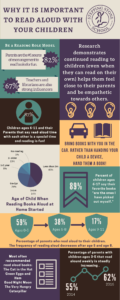The Importance of Reading Aloud
It was just like every other afternoon in fifth grade, Mr. Huff gathered my classmates and me together to read a chapter aloud from a book. This particular afternoon, we had set aside a few extra minutes to finish reading Where the Red Fern Grows by Wilson Rawls. A coming of age story about a boy, Billy, and the two dogs he loved dearly: Little Ann and Old Dan. After just a few short weeks of following Billy and his dogs through the woods chasing racoons, we came to the saddest part of the story and there wasn’t a dry eye in the entire classroom.
That school year as we sat at our teacher’s feet hanging on his every word, we followed the pages of the countless books he read aloud to us – crossing oceans of unknown depths, drifting past islands of mystery and entering imaginary lands where we joined in daring adventures. Over those nine months, our class fell in love with reading!
Looking back over twenty-five years later, the memories of those afternoons enables me to appreciate the power of reading aloud to children despite their age.
The Value of Reading Aloud
When a child begins reading on his own, it is easy to forget the importance of continuing to read aloud to him. However, research provides mounting evidence in support of the statements found in the 1985 Report of the Commission on Reading, Becoming a Nation of Readers, stating, “The single most important activity for building the knowledge required for eventual success in reading is reading aloud to children.” (p 33).
Since the 1985 report, more current research studies frequently return to the statements found within that document to support their own findings. Organizations like The Center for Teaching at the University of Iowa have compiled additional evidence-based benefits of reading aloud within a classroom to include building community and generating discussions. They also note that throughout the experience the reader models fluency and expression through her use of intonation and attention to punctuation, while the listener improves his information processing and comprehension skills while acquiring new vocabulary.
The Center for Teaching goes on to identify several anecdotal benefits of a read aloud including the participation in what is called the theory of “Narrative Transport.” As described through my earlier anecdote, narrative transport is characterized by “absorption into a story’s narrative flow.” Through narrative transport, “The listener may forget her surroundings and engage her visual, auditory, kinesthetic and emotional sense and may experience a sense of time distortion.” It is stated here as well, that “this is a qualitatively altered state that is supportive of active and deeper learning.” (Center for teaching,)
Reading Aloud at Home
Though most research in this area focuses heavily on best practices in the classroom, each study seems to circle back to the importance of reading aloud at home beginning from the earliest days after a child’s birth.
A 2014 report by Scholastic Publishers highlights patterns common among elementary school children who claim to enjoy reading. The two highest indicators were that these children were read to regularly at home and had limited time spent online.
Reading Aloud in School
In our early childhood classrooms, Stepping Stone School teachers share the joy of reading as we invite children to participate together in read alouds. We believe this activity to be foundational in building a lifelong love of reading in addition to introducing new vocabulary and learning new information.
Our Platinum Learning for Life Curriculum™ provides hands-on learning weaving well designed activities around stories read aloud. Teachers break to check for comprehension providing time for children to absorb what they are hearing and to connect their new knowledge with what they have previously learned.
Whether at home or at school, children of all ages listening to a read aloud are invited to share in an experience as they travel through the pages of a book.
Resources
Anderson, R. C.; & Others. (1985). Becoming a Nation of Readers: The Report of the Commission on Reading. Retrieved from http://files.eric.ed.gov/fulltext/ED253865.pdf
Joyce, A. (2017, Feb. 16). Why it’s important to read aloud with your kids, and how to make it count. Retrieved from https://www.washingtonpost.com/news/parenting/wp/2017/02/16/why-its-important-to-read-aloud-with-your-kids-and-how-to-make-it-count/?utm_term=.984453e9b163
Rich, M. (2015, Jan. 8). Study Finds Reading to Children of All Ages Grooms Them to Read More on Their Own. Retrieved from https://www.nytimes.com/2015/01/08/us/study-finds-reading-to-children-of-all-ages-grooms-them-to-read-more-on-their-own.html
University of Iowa Center for Teaching. (n.d.). What Are the Benefits of Reading Aloud? An Instructional Format for College-Age Learners. Retrieved from https://teach.its.uiowa.edu/sites/teach.its.uiowa.edu/files/docs/docs/What_are_the_Benefits_of_Reading_Aloud_ed.pdf
